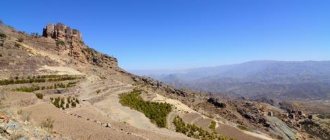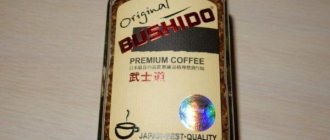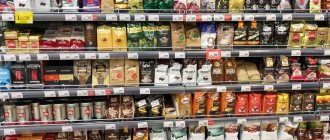Types of coffee
Varieties of coffee can be divided into several classifications:
- Grain variety
- Roasting degree
- Place of cultivation
Coffee bean variety
Of the dozen varieties of this plant in industrial production, 2 main ones are used to obtain good black coffee - Arabica (~70%) and Robusta (~30%). They make up 98% of all products.
Arabica is distinguished by a rich shade of flavors, soft, delicate, pronounced aroma. It is used both in 100% form and in mixtures. Requires close attention when growing. Vulnerable to diseases and climate change.
Robusta has a simple taste, sharp, bitter and weak aroma. Used only in mixture. Not picky in care, resistant to climate change and disease.
Roasting degree
Roasting coffee greatly affects its taste. Proper roasting determines how good the coffee will be. Intuitively, it can be divided into 3 main degrees: light, medium, high. But you need to understand that each degree has differences, even a few seconds of frying affect the taste and aroma in one way or another.
Light - this level is only suitable for high quality grains. Preserves the natural soft taste of good grains, with great sourness.
Medium is the most common roast level. Balanced taste, less acidic.
High - with this roasting, the grains acquire a stronger taste. It can also add bitterness.
Place of cultivation
Since coffee is a rather finicky plant, it grows only in the equator and tropics. There are some differences in taste depending on the place of growth; characteristic features are inherent in different zones.
South America - balanced taste, almost no bitterness.
Africa - in most cases has acidic, citrus undertones.
Asia - low acidity, earthy shade, bitter taste.
The largest coffee exports come from the following countries:
- Brazil - 30%
- Vietnam - 17%
- Colombia - 12%
- Ethiopia - 6%
- Indonesia - 5%
- India - 4%
Vices and defects of natural coffee
Defects in roasted and instant coffee are most often caused by poor quality of raw coffee, violation of production technology or roasting modes. The most common defects are:
the sour smell and taste of coffee occurs due to self-heating of raw coffee beans or roasting moldy ones;
charred coffee beans (the drink takes on the smell of charred wood and an unpleasant aftertaste) are formed due to the presence of blackened beans in raw coffee (the grain has been lying on the ground for a long time, poor drying), broken beans (ears, shells) and mechanically damaged (pressed) during processing, damaged pests (bark beetles, etc.), or in case of violation of the roasting regime;
unevenly roasted grains are obtained due to insufficient drying of raw grains, the presence of raw grains in the horny and parchment shell;
whitish grains are due to the presence in the raw material of unripe, raw grains that have dried on the tree (green or cherry color);
undercooked grains appear due to the roasting of grains in the shells left behind due to poor cleaning;
The smell and taste of rancid fat are formed during long-term storage of coffee and the occurrence of oxidative processes in it.
Types of coffee drinks
What is espresso?
The basis of all coffee drinks is a drink called espresso. Espresso is prepared by flowing hot water under pressure (about 90°) through a filter with ground coffee. This is why it is called “espresso”, which means “squeezed” in Italian.
All coffee drinks are based on espresso and by adding milk, cream, ice cream, chocolate, whiskey or even lemon juice we get various delicious coffee drinks.
What is coffee made from?
Coffee is made from the seeds or beans of the coffee tree. Coffee beans contain more than 100 chemicals, including aroma molecules, proteins, starches, oils, and bitter phenols (acidic compounds), each of which has its own distinct, unique coffee flavor. The coffee tree, a member of the evergreen family, has waxy, pointed leaves and jasmine-like flowers.
Actually more like a shrub, the coffee tree can grow up to 9 meters in its wild state, but is usually pruned to between 1.5 and 3.5 meters when cultivated. Once planted, a typical tree will not produce coffee beans until it flowers, a process that typically takes about five years.
After the white petals fall off, red fruits appear, each containing two green coffee beans. Industrial production of beans requires a large number of trees: in one year, 400-500 grams of coffee can be harvested from a small bush. Because coffee cherries ripen unevenly, harvesting requires careful selection of only red ripe berries: including unripe green ones and overly ripe black ones will affect the taste of the coffee.
Coffee trees grow best in temperate climates without frost or high temperatures. High altitude plantations, located between 900 and 1800 meters above sea level, produce low-moisture beans with great flavor. Due to the positive influences of volcanic soil and altitude, the finest beans are often grown in mountainous areas. Today Brazil produces about half of the world's coffee. One quarter is produced in other Latin American countries, and Africa accounts for about one-sixth of global supply.
There are currently about 25 species of coffee trees, determined by environmental factors such as soil, weather and altitude. The two main species are coffea robusta (robusta) and coffea arabica (arabica). The Robusta strain produces less expensive beans, mainly because it can be grown in less ideal conditions than the Arabica strain. When served, coffee made from Arabica beans has a deep reddish hue, while Robusta beans have a dark brown or black appearance.
Coffee made from two main components is significantly different. Robusta beans are typically grown in large plantations where the berries are ripened and harvested at one time, thereby increasing the percentage of under-ripe and over-ripe beans. Arabica beans, on the other hand, include the bulk of premium coffee, which are typically sold as a whole bean so customers can grind their own coffee. Whether in a cafe or brewed at home, coffee made from these beans has a more subtle and less acidic taste.
Chemical composition, nutritional value of coffee
Coffee has a complex chemical composition. It contains approximately two thousand chemicals that together give it its distinctive aroma and taste.
Raw coffee beans contain fats, proteins, water, mineral salts, mycotoxins, and various water-soluble and insoluble substances. Roasted coffee beans lose most of their water (its content decreases from 11% to 3%), and their chemical composition changes depending on the degree and duration of roasting. It represents a wide range of components.
The moisture content of raw coffee plays an important role in its export and import, because All calculations are made based on the moisture content. Raw coffee beans belong to the group of products with a capillary-porous colloidal structure. The water content in raw coffee beans according to the standard adopted by the International Coffee Organization should be 12±1%. But depending on storage and transportation conditions, the moisture content of raw coffee ranges from 9-14%.
Raw coffee beans, calculated on a dry matter basis, contain 32-36% extractives, which are stable for seven years or more under normal storage conditions. The dry matter of raw coffee contains the following main components: alkaloids such as caffeine - 0.7-2.5%. This substance is colorless and odorless; in aqueous solution it gives a bitter taste. The amount of caffeine in beans varies greatly depending on the type of coffee. Caffeine is found in varying amounts in more than a hundred plants, but only coffee fruits, cocoa, guarana and tea leaves contain quite a lot of it. The degree of roasting of the beans also affects the caffeine content of the drink, with more roasted beans, such as for espresso coffee, producing less caffeine. The caffeine content of beans plays a very important role in assessing the quality of raw materials and establishing technical requirements for them. It should be remembered that caffeine, although it has a bitter taste, nevertheless has almost no effect on the taste of coffee. Therefore, it is a big misconception to associate the bitterness of coffee with the presence of caffeine in it. Bitter coffee does not mean strong at all, and vice versa - strong means bitter. In addition to caffeine, coffee beans contain another alkaloid - trigonelline. It is highly soluble in water, but is thermally unstable. When processing coffee beans, it is easily converted into nicotinic acid (vitamin PP). Unlike caffeine, it does not excite and does not have a narcotic effect, but it is involved in the formation of the taste and aroma of roasted coffee. It also contains alkaloids such as theobromine (1.5-2.5 mg%) and theophylline (1-4 mg%). It is worth mentioning a substance that is very complex in composition - kafeol. Including almost two and a half hundred components, it is the carrier of a characteristic coffee aroma.
The bitter taste is imparted to the coffee drink by complex organic substances - tannins. To neutralize them, milk or cream is added to coffee. They bind tannins and the drink loses its bitterness. Tannin content in raw coffee beans varies from 3.6 to 7.7%. During the roasting process, the amount of tannin decreases sharply and 0.5-1% remains in the finished product. A decrease in tannin during roasting is not considered a negative factor, since it contributes to the formation of the taste and color of coffee, however, with excessive heating, the tannin is completely decomposed. The hollow or “flat” taste of roasted coffee can sometimes be attributed to the disappearance of tannin.
Protein substances are contained in coffee in amounts from 9 to 19.2%; fat (lipids) - 9.4-18% (it almost completely remains in the dry residue and does not pass into the finished drink); sucrose - 4.2-11.8% (soluble carbohydrates - sucrose, fructose and galactose in the structure of roasted coffee beans occupy from 25% to 28% of all soluble components); monosaccharides - 0.17-0.65%; fiber - 32.5-33.5%; pentosans - 5-7%; tannins - 8.7-11.9%; minerals - 3.7-4.5%.
Carbohydrates account for 50-60% of the total mass of raw coffee beans. During the roasting process, profound changes occur in the composition of the carbohydrate complex of coffee. Sucrose almost completely disappears, leaving 0.56%. At the beginning of frying, the monosaccharide content drops sharply, but by the end of the process it increases significantly. Fluctuations in the composition and quantity of monosaccharides in coffee during its heat treatment are explained by the consumption of some of them for the processes of caramelization and melanoid formation, and then an increase in their concentration due to the hydrolysis of fiber, pentoses and other polysaccharides.
Raw coffee beans contain minerals such as: potassium, magnesium, calcium, sodium, iron, manganese, rubidium, zinc, copper, strontium, as well as traces of chromium, vanadium, barium, nickel, cobalt, lead, molybdenum, titanium and cadmium The content of individual mineral elements depends on the type of coffee, the growing area, the processing method, the type of mineral fertilizers applied to the soil, as well as the plant protection products used. During coffee roasting, the mineral content increases to 5-7%, which is associated with large losses of dry matter.
Coffee beans contain more than three dozen different organic acids, including organic acids such as: citric acid - 0.3%, malic acid - 0.3%, tartaric acid - 0.4%, oxalic acid - 0.05%, caffeic acid - 0 .2%, chlorogenic - 4-10.9% - deserves special attention. Chlorogenic acids include about 10 compounds found in coffee, and similar compounds are found in other plants. Even though the coffee bean loses 60% of it during roasting, the remainder is still enough to give the coffee a slightly astringent flavor. In terms of the content of chlorogenic acid, coffee beans are a unique product, because it is not found in such quantities in any other plants. It stimulates nitrogen metabolism and helps build protein molecules. The role of chlorogenic acids in the formation of coffee color during roasting is important. When heated, chlorogenic acids are destroyed and react with amino acids and proteins to form dark-colored products. Coffee beans also contain acetic, oxalic, and pyruvic acids. More than 350 aromatic substances have been identified in roasted coffee. Essential oils give roasted coffee a special aroma. The phenol products they contain have a certain antiseptic effect. The humidity of raw coffee is 9-12%. Also found in coffee are vitamins and enzymes such as: thiamine (vitamin B1), riboflavin (B2), pantothenoic acid, nicotinic acid (PP), pyridoxine (B6), vitamin B12 and tocopherol (E).
As for coffee as a drink, its nutritional value is as follows: 100 g of sugar-free drink contains: proteins - 0.2 g, fats - 0.6 g, carbohydrates - 0.1 g, calcium - 5 mg, vitamin PP - 0.6 mg, potassium - up to 9 mg, phosphorus - 7 mg, iron - 2 mg.
Coffee has virtually no nutritional value, although it contains protein. A 100-gram cup of the drink provides only 9 kilocalories. However, as a source of minerals, mainly potassium, coffee plays an important role. The importance of coffee is also important as a carrier of vitamins P, necessary for strengthening blood vessels. A cup of coffee contains 20% of the body's daily requirement for this vitamin.
Production
Drying and peeling of fruits
To begin with, the coffee beans are harvested, a process still done by hand. The fruit is then dried and peeled using one of two methods.
The dry method is a more ancient, primitive and labor-intensive process. The fruits are laid out in the sun and raked and spread out again several times during the day. When they dry out to the point that they contain only 12 percent water, the pavers become wrinkled. At this stage they are processed manually or by machine.
When using the wet method, the husks are removed before drying. The fruits are first processed in a pulping machine, which removes most of the material surrounding the beans, but some of this glue coating remains after the pulp is cooked. This residue is removed by adding enzymes in tanks where their natural enzymes digest the sticky substance over a period of 18 to 36 hours.
Once removed from the fermenting tank, the beans are washed, dried with hot air and placed in large mechanical mixers called hullers. Huller will polish the beans to a clean, glossy finish.
Cleaning and sorting beans
The beans are then placed on a conveyor belt, which carries them past workers who remove sticks and other debris. They are then graded based on the size, location and height of the plantation where they were grown.
Once these processes are complete, workers select and package specific types and grades of beans to fill orders from the various roasting companies that will complete the bean preparation. When beans (usually robusta) are harvested in undesirable conditions—hot, humid countries or coastal areas—they should be shipped as quickly as possible, as such climates are conducive to insects and fungi that can seriously damage the cargo.
When the coffee beans arrive for roasting, they are again cleaned and sorted using mechanical devices to remove leaves, bark and other remaining debris. If the beans are not supposed to be defatted, they are ready to be roasted.
Decaffeination
If coffee can be defatted, this is done using two methods. The first is using a solvent, the second is called aqueous.
In the first process, coffee beans are treated with a solvent (usually methylene chloride) that leach out the caffeine. If this degreasing method is used, the beans must be thoroughly washed to remove any traces of solvent before roasting.
The water method involves steaming the beans to bring the caffeine to the surface and then scraping off that caffeine-rich layer.
Burning
The beans are roasted in huge commercial roasters according to procedures and specifications that vary between manufacturers (specialty shops typically buy the beans directly from the growers and roast them on site). The most common process involves placing the bean in a large metal cylinder and blowing hot air into it. An older method called staggering requires placing the beans in a metal cylinder, which is then rotated over an electric, gas or coal heater.
Regardless of the method used, roasting gradually raises the temperature of the beans to 220-230 degrees Celsius. This causes the release of steam, carbon monoxide, carbon dioxide and other volatiles, reducing the weight of the beans by 14 to 23 percent. The pressure of these escaping internal gases causes the beans to swell, increasing their volume by 30 to 100 percent. Roasting also darkens the color of the beans, gives them a crumbly texture, and causes chemical reactions that imbue the coffee with its familiar aroma (that it has not yet possessed).
After roasting, they are placed in a cooling vessel in which they are mixed while cold air blows on them. If the brewed coffee is of high quality, the cooled beans will now be sent through an electronic sorter equipped to detect and eliminate beans that come out of the roasting process too light or too dark.
If the coffee is pre-prepared, the manufacturer injects it immediately after roasting. Special grinding types have been developed for each of the different types of coffee makers, as each is best suited for coffee of a certain fineness.
Instant coffee
If coffee must be instant, then it is brewed using water in huge percolators. The extract is purified from the brewed coffee and sprayed into a large cylinder. As it falls down through this cylinder, it enters a warm air stream that turns it into a dry powder.
Package
Whole coffee beans are less susceptible to loss of aroma and flavor than other types of coffee and are usually packaged in foil bags.
Pre-ground coffee should be hermetically sealed, as it retains its basic qualities less well. It is usually packaged in impermeable plastic film, aluminum foil or cans.
Instant coffee easily absorbs moisture, so it is vacuum packed in tins or glass jars before shipping to retail stores
Making coffee video
Features of coffee production today
The production of powdered coffee is practically not considered by many entrepreneurs today: it is quite difficult to equip lines for its production, because the corresponding technology is practically not implemented, it is outdated and its tendency to decrease demand can clearly be noted. As one of the most practical existing options for the production of such a product, its production is considered as a related product to a similar food product.
As an argument, we can consider the following statistics: let’s say the volume of instant coffee consumed in Russia is 24 thousand tons, and the volume of freeze-dried instant coffee is 4 thousand tons, while the latter has a significant upward trend. In this case, if this type of coffee is not yet produced in Russia on a large scale, a start-up business can get an excellent start, and become, at a minimum, widespread and in demand on a regional scale. If the capacity of both of these production lines is about 500 tons per year, then the choice becomes obvious. The profitability of freeze-dried coffee may be slightly lower than that of a product produced in granules, but when it reaches the point of recovery of financial investments (which usually occurs within a couple of years), it will only increase.
In addition, as already noted, high-quality instant coffee can withstand significant increases in cost without a change in demand. If you manage to occupy a monopoly position, in this case the payback will increase several times more - the price for products from a local manufacturer, one way or another, will be lower than for a foreign one.
For a full-fledged production line, a coffee production plant may require a whole list of necessary equipment:
- containers for raw materials and semi-finished products,
- scales,
- separators and coolers,
- vibrating screens,
- conveyors,
- granulators, and much more!
Together they form a coffee production line, the total cost of which, at the most minimal costs, reaches 100 million rubles. Production with equipment using Freeze Dried technology will cost from 800 million if you start it from scratch. If the necessary production space and other infrastructure are available, then the production of instant coffee will cost several times less - approximately 150 - 300 million.
How to cook in a Turk
To brew delicious black coffee in a Turk on the stove and not only, you need to follow some rules and nuances and then you will fully enjoy this noble drink. Let's look at the stages of brewing coffee at home point by point.
- Heat the empty Turk a little over low heat.
- Pour ground coffee into the bottom and warm it up a little.
- Pour water up to the narrow neck
- Cook over medium or slightly lower heat until foam appears
- Pour into cups
These are the main points of cooking in a cezve (aka Turk). But in order for the coffee to be tasty and aromatic, you need to know the following nuances:
- A pinch of salt at the bottom of the Turkish coffee before cooking will make the taste softer and you should not be afraid that the coffee will be salty. You can also add a little sugar, cinnamon or anise at this stage.
- A good proportion of ground coffee is 1 teaspoon per 100 ml of water.
- If the coffee is in beans, it is better to grind it before brewing, since ground coffee quickly loses its taste and aroma.
- Water must be purified or bottled.
- Do not let it boil, as the foam will be destroyed, and this is perhaps the most delicious part of the drink.
- To help the coffee settle to the bottom faster after brewing, you can lightly tap it on the edge of the table.
- A preheated cup will retain the aroma longer.
Certification
Mandatory certification of imported products is carried out in accordance with the requirements of the “Temporary Procedure for the Import of Goods into the Territory of the Russian Federation for which confirmation of their safety is required.”
By decision of the Certification Body, tests can be carried out using a reduced range of indicators, provided that the remaining indicators are documented (certificate for raw materials, hygienic certificate, etc.). When carrying out mandatory certification of natural coffee, products are identified for compliance with the requirements of regulatory documentation. If during testing it is discovered that the product does not comply with the declared name, then the certificate is not issued and the application is reissued.
Sampling and preparation for testing for certification of the safety of natural coffee is carried out in accordance with regulatory documents for specific products.
Tests for certification purposes are carried out in accordance with the methods established by the ND and health authorities.
Certification of coffee can be carried out in the UTZ Certified system - a special certification system that confirms compliance with international standards specifically in the field of coffee production. The presence of this certificate from the manufacturer makes it clear to consumers that the coffee was grown and produced in compliance with all standards for the protection of natural resources, and all necessary social and quality requirements for the cultivation and further processing of this type of coffee were met.











